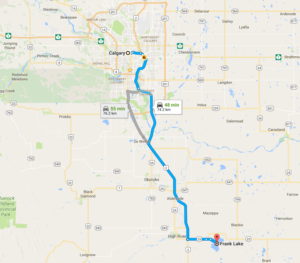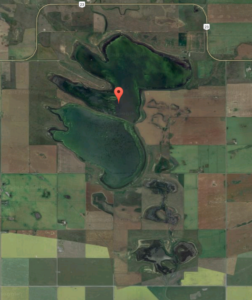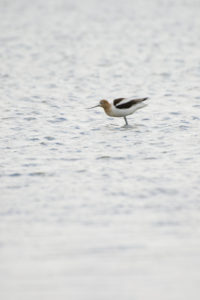So, you want to go birding? Today’s blog is going to be all about a great location just outside of Calgary, that you can visit to enjoy the outdoors and see several bird species, and if you’re lucky, some mammals as well.
Let us introduce you to Frank Lake! Frank Lake is only about 45 minutes south of Calgary. To get to the lake, take Highway 2 southbound for about 50 km, turn off on the eastbound exit to Highway 23, and head east for another 5 km. The turn-off for the lake will be on the south side of the road and will lead you to the parking lot.
(Image courtesy of Google Maps 2017a)
Frank Lake is considered to be a wetland complex and boasts thick vegetation along the shorelines that provides excellent habitat for waterfowl, marsh birds, shorebirds, and other wildlife. The wetland complex consists of three basins that total 3,100 acres of wetland, and an additional 1,700 acres of surrounding managed upland (Ducks Unlimited 2017). The surrounding landscape is mostly agriculture and pasture land.
(Photo courtesy of Google Maps 2017b)
This location attracts several animal species: a total of 194 bird species and 16 mammal species have been recorded here, as well as 190 plant species (Ducks Unlimited 2017).
Frank Lake is currently a managed and monitored wetland and is considered one of the most important wetlands in southern Alberta for breeding water birds (Bird Studies Canada 2017). Prior to management of Frank Lake, the area had seen several years of complete dryness, and on the complete opposite end, had also seen several years of flooding. By managing the wetland complex that is Frank Lake as a permanent waterbody, wildlife habitat is maintained. Ducks Unlimited worked with industry, municipal, provincial and federal governments in 1988 to determine a long-term plan to maintain and protect water levels of the lake from drought and flooding (Ducks Unlimited 2017). Fast forward almost 30 years and you will see the thriving wetland that it is today!
Furthermore, many artificial structures such as nest boxes, nest platforms, and rock islands have been placed throughout the wetland to enhance the habitat for wildlife that nest and live here (Bird Studies Canada 2017).
My personal favourite thing about Frank Lake is the observation blind (a little hut on the water that shields you from the view of birds on the lake). The observation blind allows you to be able to see birds closer up, as they won’t swim away from you like they would if you were out in the open. This is also a great spot for those who are fond of photographing birds and waterfowl! The observation blind makes it so you don’t have to stay still for hours on end to be able to catch a great photo!
Several thousand Franklin’s gulls have also been known to nest here, with the colony population at upwards of 10,000 individuals reported in 1971 (Bird Studies Canada 2017). Some of the other more common species that are frequently observed here include the eared grebe, black-crowned night-heron, California gull, ring-billed gull and common tern (Bird Studies Canada 2017). Some of the more uncommon or unexpected sightings include the black-necked stilt, Baird’s sparrow, white-faced ibis and Clark’s grebe (Bird Studies Canada 2017; Smith 1993). Several listed species (Alberta Government 2015) have been observed here, such as the peregrine falcon (At Risk), ferruginous hawk (At Risk), long-billed curlew (Sensitive), and short-eared owl (May be At Risk)(Bird Studies Canada 2017).
Pictured here are a yellow-headed black bird, a ruddy duck, an eared grebe, an American avocet, and a muskrat.
(Photos courtesy of Tayler Hamilton)
Before you venture out to Frank Lake, we encourage you to:
– First, check the weather and wear appropriate clothing; and,
– Second, but more importantly, check out this guide created by the Cornell Lab of Ornithology: https://ebird.org/ebird/canada/barchart?byr=1900&eyr=2014&bmo=1&emo=12&r=CA-AB_079.
This handy tool allows you to see what bird species have been reported at the lake and during what times of the year!
As stewards of wildlife we ask you to be respectful while visiting Frank Lake (or any natural area) and to stay on the designated pathways, to not purposefully disrupt any wildlife that may be present, and to make sure you leave no garbage behind.
As always, if you see any wildlife in distress, please don’t hesitate to call us at 403-946-2361 to seek advice or assistance in the matter. Stay safe and have fun!
For specific directions on how to get to Frank Lake, follow this link:
References:
Alberta Government. 2015. Alberta Wild Species General Status Listing – 2015. Available at: https://aep.alberta.ca/fish-wildlife/species-at-risk/albertas-species-at-risk-strategy/general-status-of-alberta-wild-species/documents/SAR-2015WildSpeciesGeneralStatusList-Mar2017.pdf. Accessed July 18, 2017.
Bird Studies Canada. 2017. Frank Lake (south), High River, Alberta. Available at: https://www.ibacanada.ca/site.jsp?siteID=AB079&lang=EN. Accessed July 18, 2017.
Cornell Lab of Ornithology. 2015. eBird Canada: Bird Observations, Frank Lake. Available at: https://ebird.org/ebird/canada/barchart?byr=1900&eyr=2014&bmo=1&emo=12&r=CA-AB_079. Accessed July 18, 2017.
Ducks Unlimited. 2017. Frank Lake. Available at: https://www.ducks.ca/places/alberta/frank-lake/. Accessed July 18, 2017.
Google Maps. 2017a. Map data. Available at: https://www.google.ca/maps/dir/Calgary,+AB/Frank+Lake,+Foothills+No.+31,+AB/@50.8057356,-114.1727583,10z/data=!3m1!4b1!4m13!4m12!1m5!1m1!1s0x537170039f843fd5:0x266d3bb1b652b63a!2m2!1d-114.0708459!2d51.0486151!1m5!1m1!1s0x5371ecedfd7a943f:0x20cbda3ccfccfbba!2m2!1d-113.7109326!2d50.5609413. Accessed July 18, 2017.
Google Maps. 2017b. Map data. Available at: https://www.google.ca/maps/place/Frank+Lake/@50.5539155,-113.7178315,11751m/data=!3m1!1e3!4m5!3m4!1s0x5371ecedfd7a943f:0x20cbda3ccfccfbba!8m2!3d50.5609413!4d-113.7109326. Accessed July 18, 2017.
Smith, Wayne, W. 1993. Frank Lake. Revised in 2012. Available at: https://www.naturecalgary.com/wp-content/uploads/2013/05/location_franklake_GWmap.pdf. Accessed July 18, 2017.
Wagner, G. 2012. Map of Frank Lake. Birds Calgary. Available at: https://www.birdscalgary.com/birding-resources/frank-lake/. Accessed July 18, 2017.













10 thoughts on “A Visit to Frank Lake”
My husband and I stopped at Frank Lake conservation area and we came across a locked gate across the roadway. I am waiting for a hip operation so can’t walk far right now. Can you tell me why this gate was locked and when or if it will be open again. Perhaps when the road is unlocked so we can drive closer to the lake. Thanks
Hello Colleen,
Unfortunately we’re not aware of why the gate is locked and we’re not sure when it will be open again. Looking online, it seems that the gate is closed for the season but may open up again in April or May. Thank you!
Pingback: Interview with Christyann Olson: Alberta Wilderness Association – I AM CALGARY
Can you kayak there ?
Hi Dave, unfortunately we don’t know and don’t have a contact there that could help. Sorry we couldn’t be of more help!
Just wondering if the walking trails are open year round; I have a small group of kids who want to earn their snowshoeing badge. I am also looking for a place to take them ice fishing so if that is possible at Frank Lake I would like to know as well but my first guess would be no likely as it is a conservation area.
Hi Kevin,
Unfortunately we are not sure on the answers to these questions, but asking in one of the Alberta bird groups on Facebook may help?
For those who were asking about kayaking and fishing and whatnot at Frank Lake, Wikipedia claims the lake is controlled by Ducks Unlimited Canada as a reclaimed wetland. They’re probably a good start in asking what uses are available.
I came for a visit on April 19, 2020 and Frank Lake is closed. I’m not sure if this is related to COVID 19 or it’s too early in spring.
Had a great trip to Frank Lake last Sunday. Saw a lot of avians such as Trumpeter Swans, Double crested Cormorants, Canada Geese, Snow geese, Pelicans, coots , Shovellers, pintail , Teal , Avocets, Stilts and more. Such an educational place to bring kids to learn of conservation measures that assist the proliferation of waterfowl and mammals in a prairie ecosystem. Love the atmosphere there with the raucous noise of several species vocalizing at the same time. The sights and sounds are amazing there and the level walking trails good for seniors and kids alike. Will visit Frank Lake often in all seasons.